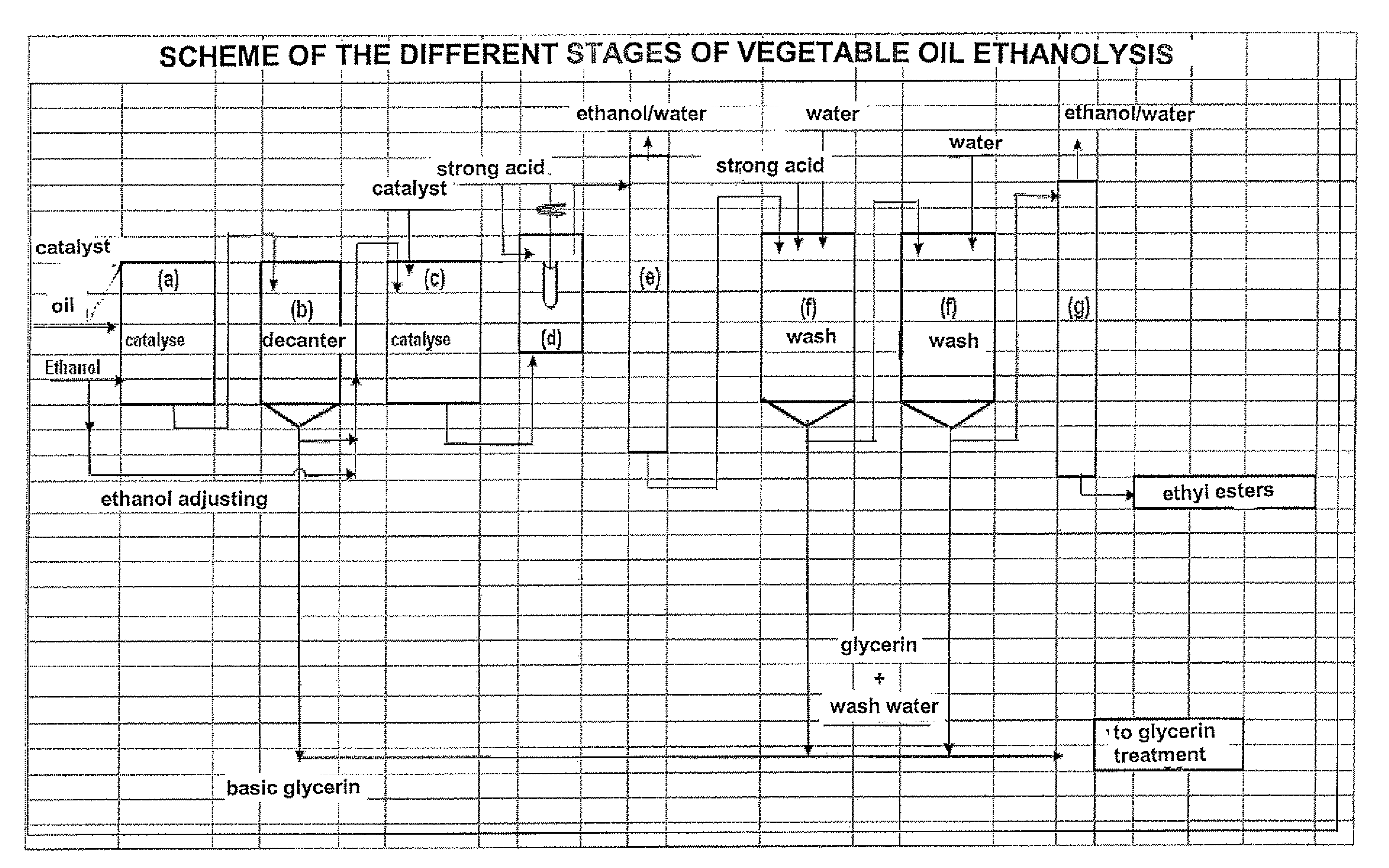Refined method for manufacturing ethyl esters from fatty substances of natural origin
a technology of ethyl esters and fatty acids, which is applied in the direction of fatty acid chemical modification, fatty oil/fat recovery, fatty oil/acid recovery from waste, etc. it can solve the problems of inability to obtain a natural separation of glycerol, inability to achieve a single reaction stage high conversion rate, and few ethanolysis methods described
- Summary
- Abstract
- Description
- Claims
- Application Information
AI Technical Summary
Benefits of technology
Problems solved by technology
Method used
Image
Examples
example 1
Comparative
[0057]Ethanolysis Reaction
[0058]500 g refined colza oil of alimentary quality and 180 g ethanol containing at most 1000 ppm water, which corresponds to an alcohol / oil stoichiometry of 2.3, is fed into a stirred double-walled glass reactor equipped with a bottom valve and heated to 70° C. 8 g of a 30% methanolic sodium methylate solution is added as soon as a temperature of 70° C. is reached. Stirring and the 70° C.±2° C. temperature are maintained for 60 minutes.
[0059]Samples are taken after 20, 30, 45 and 60 minutes. On each sample, the active to catalyst is immediately destroyed through the action of a 10% aqueous sulfuric acid solution, which freezes the conversion. The supernatent ester phase is then analyzed.
[0060]Liquid gel-permeation chromatography allows to determine the composition of the mixture of esters and of partial glycerides.
[0061]There is no more conversion evolution between 45 and 60 minutes of catalysis time, which means that thermodynamic equilibrium o...
example 2
Comparative
[0067]Methanolysis Reaction
[0068]500 g refined colza oil of alimentary quality and 125 g methanol containing at most 1000 ppm water, which corresponds to an alcohol / oil stoichiometry of 2.3, is fed into a stirred double-walled glass reactor equipped with a bottom valve. 8 g of a 30% methanolic sodium methylate solution is added as soon as a temperature of 70° C. is reached. Stirring and the 70° C.±2° C. temperature are maintained for 60 minutes.
[0069]Samples are taken after 20, 30, 45 and 60 minutes. On each sample, the active catalyst is immediately destroyed through the action of a 10% aqueous sulfuric acid solution, which freezes the conversion. The supernatent ester phase is then analyzed.
[0070]Liquid gel-permeation chromatography allows to determine the composition of the mixture of esters and of partial glycerides.
[0071]There is no more conversion evolution between 45 and 60 minutes of catalysis time, which means that thermodynamic equilibrium of the transesterifica...
example 3
According to the Invention
[0078]1000 g refined colza oil of alimentary quality and 266 g ethanol containing 3000 ppm water, respecting an alcohol / oil stoichiometry of 1.7, is fed into a stirred glass reactor equipped with a bottom valve and heated to 70° C. 10 g of a 30% methanolic sodium methylate solution is then added. Stirring and the 70° C.±2° C. temperature are maintained for 60 minutes (stage (a)).
[0079]In stage (b), the reaction medium is decanted at a temperature close to 60° C. After 15 to 20 minutes decantation, 95 g of a glycerin solution consisting of glycerin, ethanol, ethyl esters, sodium soaps and sodium alcoholates (mixture of methylate, ethylate and glycerate) is drawn off.
[0080]After this first transesterification reaction, the composition of the mixture of esters is as follows (in % by mass):
[0081]ethyl and methyl esters: 91.5
[0082]triglycerides: 0.9
[0083]diglycerides: 2.6
[0084]monoglycerides: 3.7
[0085]sterols and sterol esters: 1.3.
[0086]A second transesterifica...
PUM
| Property | Measurement | Unit |
|---|---|---|
| temperature | aaaaa | aaaaa |
| temperature | aaaaa | aaaaa |
| temperature | aaaaa | aaaaa |
Abstract
Description
Claims
Application Information
 Login to View More
Login to View More - R&D
- Intellectual Property
- Life Sciences
- Materials
- Tech Scout
- Unparalleled Data Quality
- Higher Quality Content
- 60% Fewer Hallucinations
Browse by: Latest US Patents, China's latest patents, Technical Efficacy Thesaurus, Application Domain, Technology Topic, Popular Technical Reports.
© 2025 PatSnap. All rights reserved.Legal|Privacy policy|Modern Slavery Act Transparency Statement|Sitemap|About US| Contact US: help@patsnap.com


